100+ ChatGPT Statistics 2024
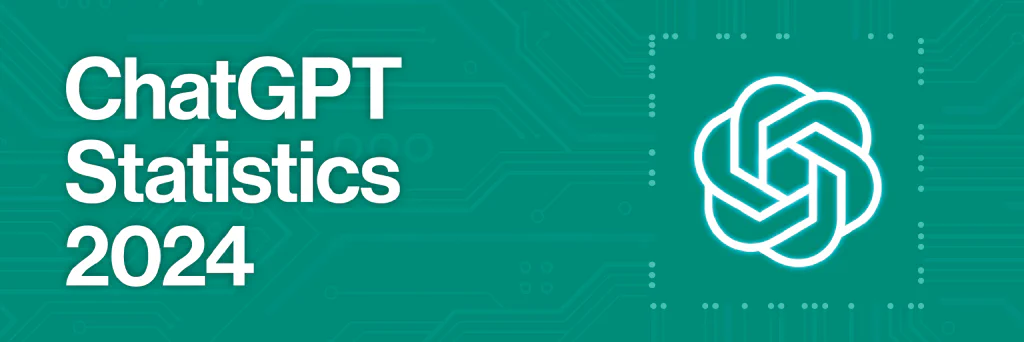
The release of ChatGPT was a watershed moment in AI development. Launched on 30 November 2022, the program took the internet by storm, surpassing one million subscribers in just five days.
With its groundbreaking language model, ChatGPT redefined the expectations of AI usage, understanding human prompts, and carrying out tasks to previously unseen levels. As such, ChatGPT was quickly adopted by many individuals and businesses as a way to assist, or even replace, a number of day-to-day tasks.
But what does the future of ChatGPT look like? To find out more, AIPRM has put together over 100 ChatGPT statistics to look at numerous areas such as growth, usage, and public opinions on ChatGPT.
Top 10 ChatGPT statistics #
- ChatGPT had approximately 180 million users as of December 2023.
- ChatGPT generates 1.7 billion monthly site views, on average.
- Nearly 15% of ChatGPT’s users (14.4%) are based in the US.
- It took five days for ChatGPT to reach one million users and two months to reach 100 million.
- The average AIPRM user spent nearly four hours (231 minutes) per session on ChatGPT in the second week of January 2024.
- ChatGPT is forecast to generate $1 billion in 2024.
- More than a third (34.44%) of ChatGPT users are aged between 25 and 34.
- Nearly six in 10 (59.7%) ChatGPT users are male.
- Seven nations, including China and Russia, cannot access ChatGPT.
- Businesses in the technical industry (27.8%) are most likely to use ChatGPT as part of their business function.
ChatGPT user statistics #
The latest ChatGPT statistics found that the program had approximately 180 million users, as of December 2023. Since its release in October 2022, the program has generated around 1.7 billion monthly site views, on average.
How does ChatGPT’s growth compare with other online platforms? #
ChatGPT currently ranks second when it comes to the time it takes for online platforms to reach one million users. The AI platform surpassed a million subscribers within just five days of its release – a record that has since been surpassed by Instagram Threads (two hours).
A breakdown of the number of days taken for various online platforms to reach one million users
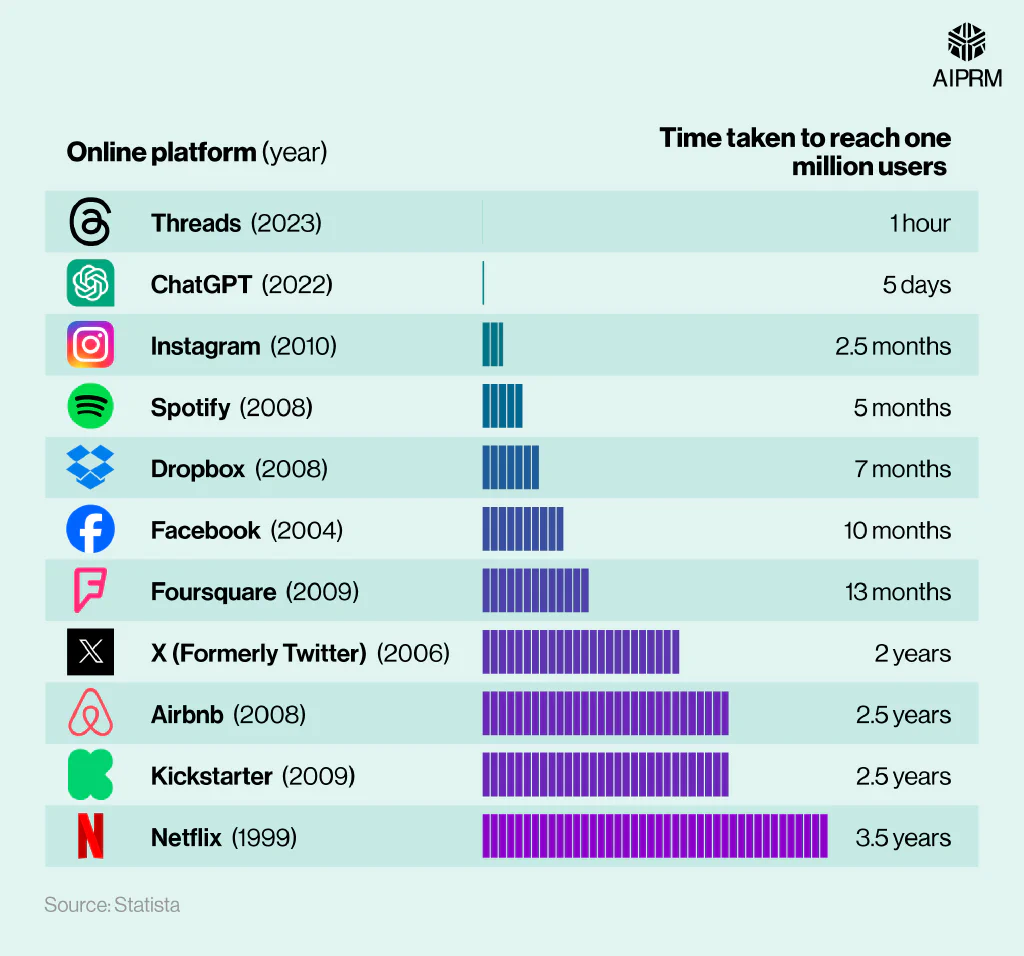
When compared to other prominent online platforms, it took ChatGPT roughly 93% less time to reach one million users than Instagram (2.5 months) and 97% less than Spotify (five months).
Additionally, ChatGPT’s figures mean that it reached one million users more than 200 times quicker than Netflix reached one million subscribers (3.5 years) and more than 140 times faster than X (formerly Twitter).
A breakdown of the number of days taken for various online platforms to reach 100 million users
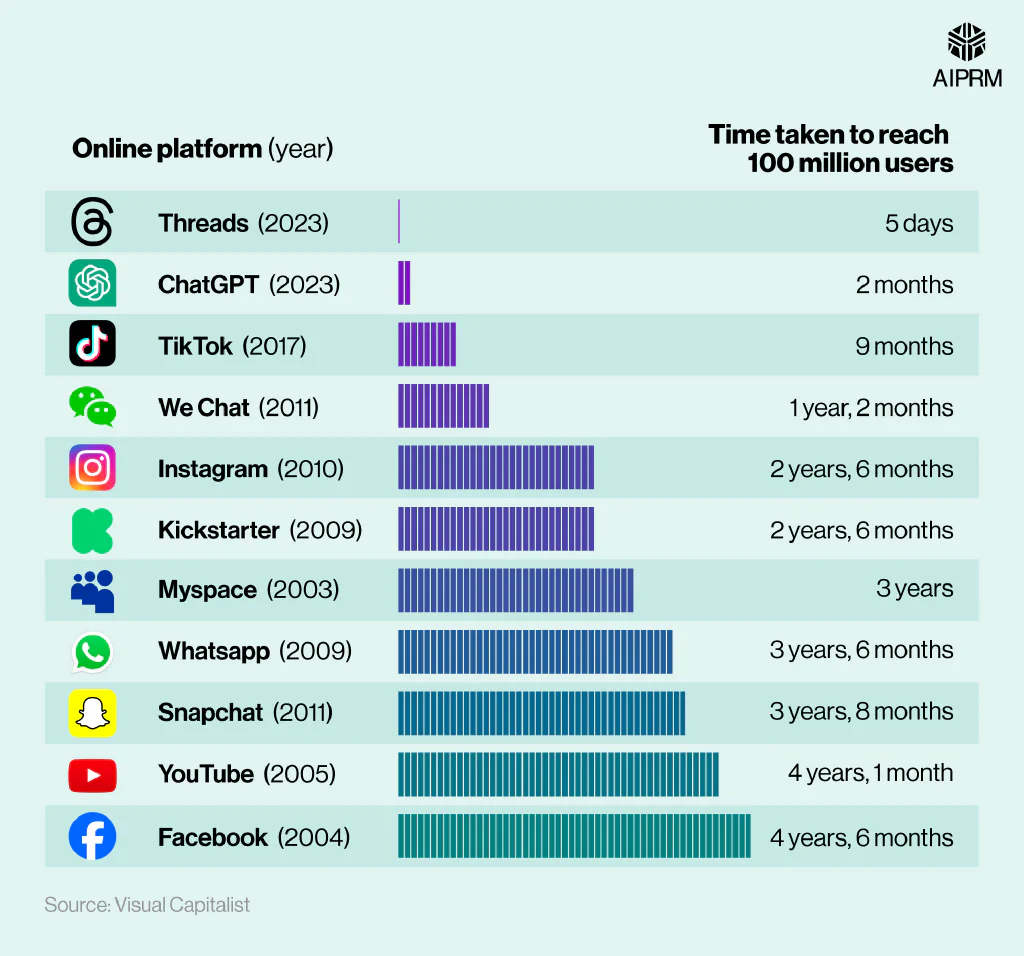
Recent ChatGPT statistics show that the AI platform reached 100 million users far quicker than many other established online platforms. It took ChatGPT just two months to surpass the 100 million users mark – the second fastest overall.
The only platform that reached this total quicker was Instagram Threads, which did so in five days – around 90% less time than ChatGPT. However, the time taken for ChatGPT to reach 100 million users was:
- More than four times quicker than TikTok (nine months).
- 15 times faster than Instagram (two years, six months).
- More than 50 times quicker than Facebook (four years, six months).
What is the total number of ChatGPT users worldwide? #
ChatGPT usage stats show that the program remains comfortably behind the most popular online outlets when it comes to site visits. With a monthly average total of around 1.7 billion visitors, ChatGPT’s total remains 98% lower than Google – the site with the most monthly visits.
A breakdown of the average monthly site visitor stats of ChatGPT compared to other popular websites
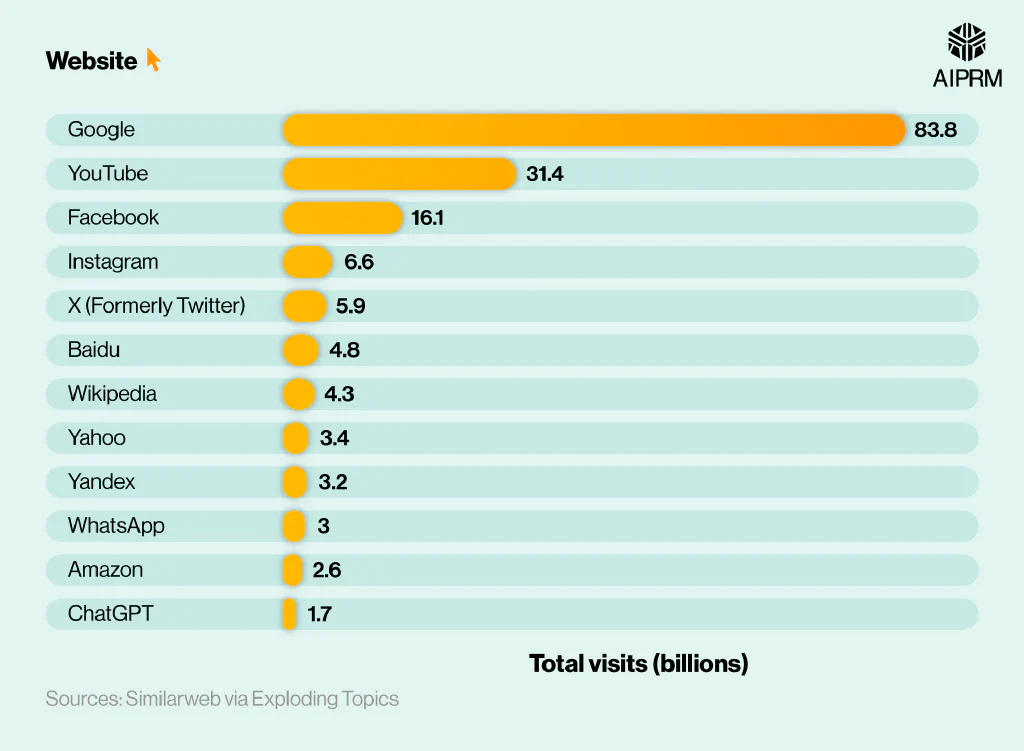
Number of ChatGPT users by month #
The number of monthly ChatGPT visitors remained consistently above one billion throughout 2023. According to ChatGPT statistics, the site received approximately 1.6 billion visitors in December 2023 – a fall of nearly 132 million from the previous month.
A monthly breakdown of the number of ChatGPT site visitors between November 2022 and December 2023
| Month | Number of visits | Change in the number of visits from the previous month | Percentage change over the previous month (%) |
|---|---|---|---|
| November 2022 | 152.7 million | - | - |
| December 2022 | 266 million | + 113.3 million | + 74.2% |
| January 2023 | 616 million | + 350 million | + 131.58% |
| February 2023 | 1 billion | + 384 million | + 62.34% |
| March 2023 | 1.6 billion | + 600 million | + 60% |
| April 2023 | 1.8 billion | + 200 million | + 12.5% |
| May 2023 | 1.8 billion | - | - |
| June 2023 | 1.6 billion | - 200 million | - 12.5% |
| July 2023 | 1.5 billion | + 100 million | - 6.25% |
| August 2023 | 1.4 billion | + 100 million | - 6.67% |
| September 2023 | 1.5 billion | + 100 million | + 7.14% |
| October 2023 | 1.7 billion | + 200 million | + 13.33% |
| November 2023 | 1.7 billion | - 15.6 million | - |
| December 2023 | 1.6 billion | - 131.6 million | - 7.83% |
(Source: Similarweb and Exploding Topics)
ChatGPT received more than 150 million (152.7 million) visitors in its first full month online (November 2022), with this figure reaching 266 million by December – a month-on-month rise of nearly 75% (74.2%).
The total number of visitors more than doubled to 616 million by January 2023 (+131.58%) before reaching the one billion mark for the first time the following month. Since March 2023, site visitation has fluctuated consistently between 1.4 billion and 1.8 billion, with the highest of these figures occurring in April and the lowest in August.
The latest figure for December 2023 means that ChatGPT’s traffic has enjoyed a year-on-year rise of more than 950% – an increase of more than 1.4 billion visitors.
Number of ChatGPT downloads by month #
ChatGPT stats show that the program was downloaded nearly 14 million times in December 2023. This represents an increase of nearly 260% from May 2023, when the number sat just below four million.
A monthly breakdown of the total ChatGPT app downloads worldwide
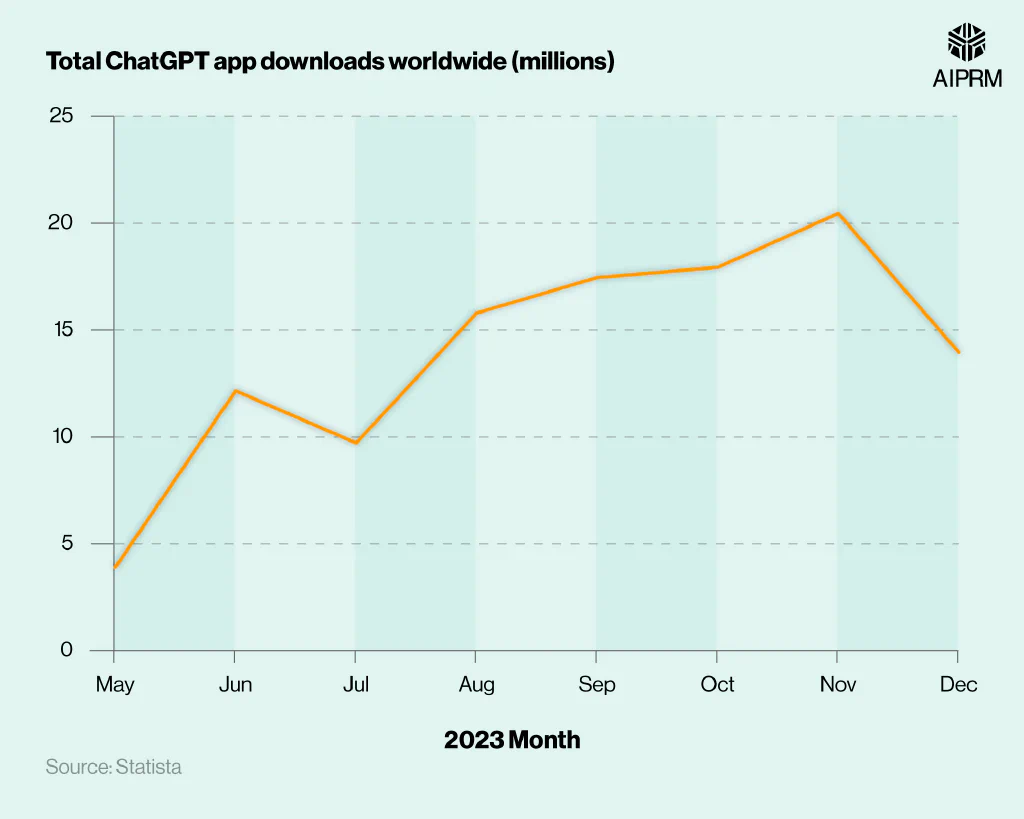
Total downloads rose sharply in the summer of 2023, with figures more than trebling from around 3.9 million in May to just under 12.2 million in June (+213%). A 20% decline in July 2023 (9.72 million) was followed by a jump of nearly two-thirds (63%) in August (15.8 million).
A continued rise throughout Autumn 2023 saw total downloads peak at just under 20.5 million in November before falling by nearly a third (-32%) in December, at 13.96 million.
ChatGPT market statistics #
ChatGPT in-app revenues by month/year #
Recent ChatGPT market statistics found that the program was estimated to have generated $200 million in revenue in 2023.
This is a rise of at least 1,900% from 2022 when, following its launch in October of that year, the program was projected to have generated less than $10 million,
A breakdown of the projected revenues of ChatGPT by year
| 2022 | Less Than $10 million |
| 2023 | $200 million |
| 2024* | $1 billion |
(Source: Demand Sage via Fortune)
Values for these years are estimated/projected
The latest projections for 2024 expect ChatGPT’s annual revenue to reach $1 billion. This would equate to a year-on-year rise of 400%.
ChatGPT user habits #
How long does the average ChatGPT visitor spend on the site? #
The average ChatGPT user spends a total of seven minutes and 46 seconds on the site during a single visit. This figure is around a quarter (28%) less than the typical Google visitor spends on the site (10 minutes, 49 seconds) and 60% less than the average YouTube user (19 minutes, 35 seconds).
A breakdown of the average visit duration of ChatGPT users compared to other popular sites
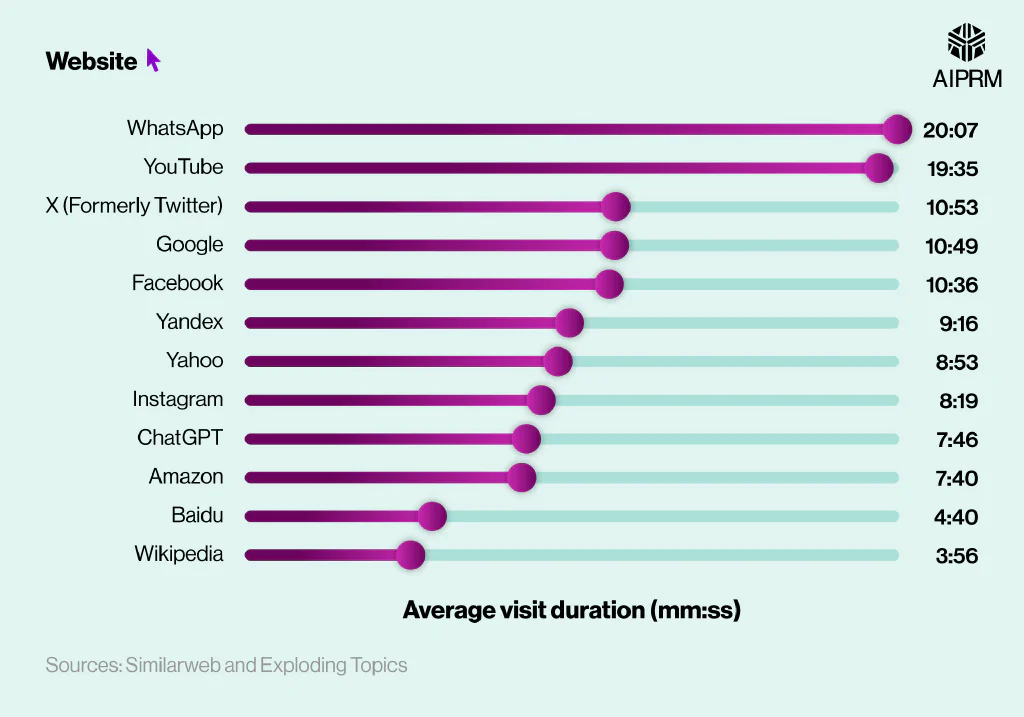
ChatGPT users typically spend more time on the site than Amazon visitors. The average visiting time for Amazon users was seven minutes and 40 seconds – around 1% less than ChatGPT.
Wikipedia has the lowest average browsing time of all sites in the study, with its average time of three minutes and 56 seconds around 49% less than ChatGPT.
When it came to AIPRM subscribers using ChatGPT, the average session time was substantially higher, at 240 minutes. This is a rise of more than 3000% from the typical ChatGPT user and highlights how much AIPRM users have integrated the program into their daily tasks and workflows.
What is the bounce rate of ChatGPT compared to other sites? #
Around one in three ChatGPT visitors leave after the first page, with the AI platform recording a bounce rate of 32.14%. This means that ChatGPT has a bounce rate around 3% lower than Instagram (35.23%), 7% lower than WhatsApp (39.78%), and 27% less than Wikipedia (59.69%).
A comparative breakdown of the bounce rate of ChatGPT vs other popular websites
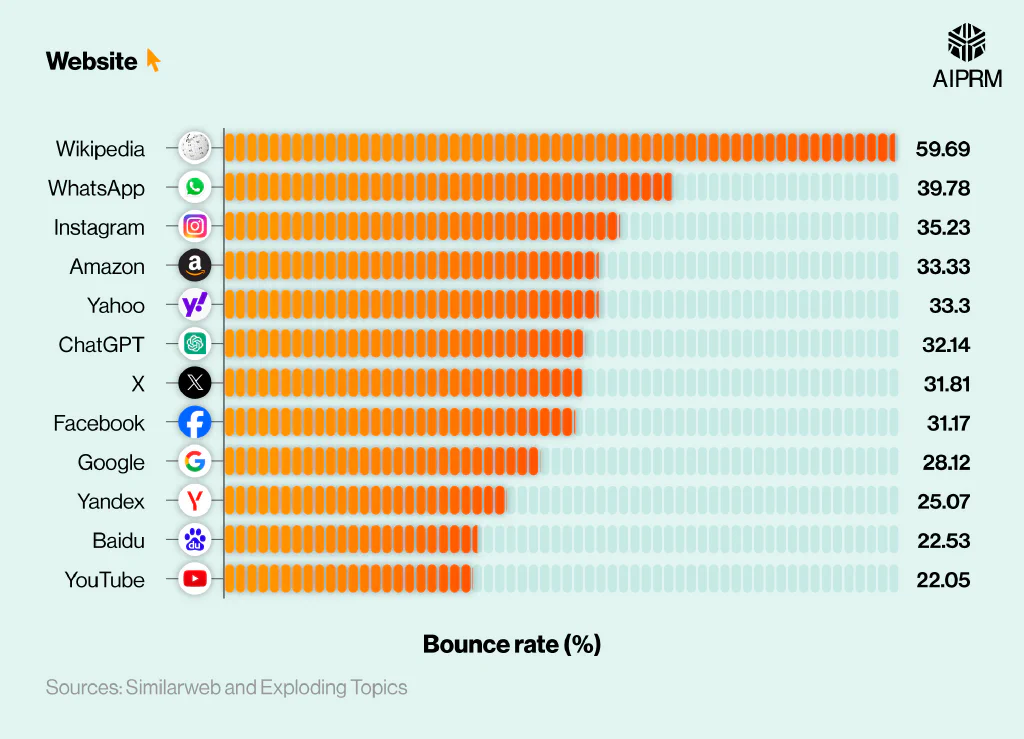
When compared to other prominent online platforms, ChatGPT’s bounce rate sat somewhere in the middle. Despite recording a lower number than the likes of Instagram, ChatGPT’s bounce rate was more than 4% higher than Google (28.12%) and over 10% more than YouTube (22.05%).
How long does the average AIPRM user spend on ChatGPT per session? #
The latest ChatGPT statistics found that the median average session time for the circa 2 million AIPRM users was exactly 4 hours (240 minutes) between March and November 2023.
Weekly median session times have risen steadily since the second week of March 2023, when they stood at just over 2.5 hours (159 minutes). From the end of March onwards, median session times were consistently above 200 minutes, rising as high as five hours (304) minutes in the first week of April.
After a median average time of just above 2.5 hours (159 minutes) in the week beginning 13 March 2023, the average session time accelerated 60% the following week, rising to more than four hours (255 minutes).
A breakdown of the median average ChatGPT session time for AIPRM users between March 2023 and January 2024
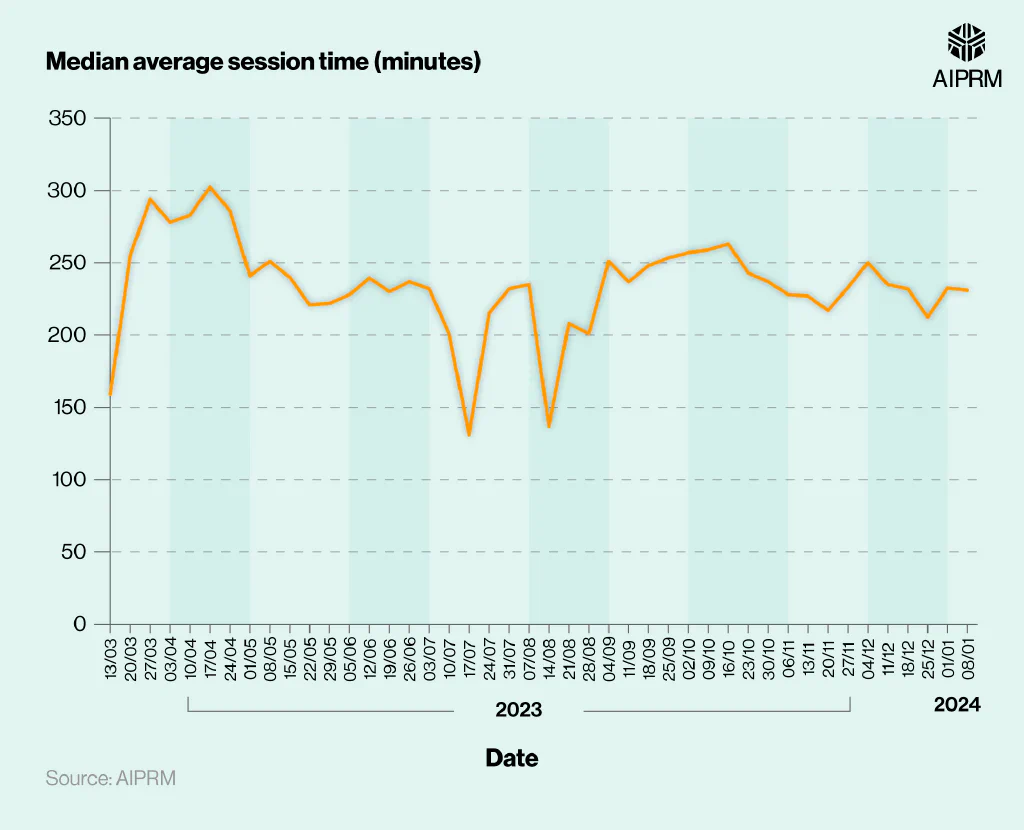
The only weeks when median session times dropped below 200 minutes occurred in July and August when there were known product outages. Since September 2023, weekly median times have fluctuated between 200 and 260 minutes, representing a slight fall from the peak times recorded in April.
The high average session time suggests that most AIPRM subscribers have ChatGPT open consistently throughout the working day. The slight drop from peak times in April may be down to a reduction in ‘practice time’ as people become more familiar with the product.
What activities are people using ChatGPT for? #
We conducted a survey asking 6,000 internet users about their experience using ChatGPT for a range of tasks. Our results found that education and office based tasks were the most popular uses, with the top 3 most popular activities belonging to one or both these fields. .
More than 6% of respondents claimed they’d used the program to write extended prose, like essays and articles. This was the highest total of any activity in the survey and more than 0.5% higher than the next most common task, writing emails and letters.
A breakdown of the percentage of survey respondents who’ve used ChatGPT for various tasks
| Writing extended prose (i.e. essays, articles) | 6.1% |
| Writing emails and letters | 5.4% |
| Creative writing (i.e. songs/poetry/novels) | 4.1% |
| Social media posts | 3.4% |
| Writing speeches | 3.2% |
| Translation | 3.0% |
| Dating apps (i.e. communication, writing profile) | 1.9% |
| Job applications | 1.8% |
| Coding | 1.3% |
| Marking exams/coursework | 0.9% |
| Cooking | 0.7% |
| Healthcare (i.e. diagnosis, finding medical solutions) | 0.2% |
| Other (Please specify) | 1.5% |
| None of the above | 82.8% |
(Source: AIPRM)
According to our survey, just over one in 20 (5.4%) people have used ChatGPT to write emails or letters. This was nearly 2% higher than the next most popular task (creative writing) and the only other task to score above 5%.
At the other end of the scale, a range of personal use activities received the lowest scores. As little as one in 500 (0.2%) had used ChatGPT for healthcare assistance, with just under one in 50 (1.9%) claiming they’d used the tool to help communicate on dating apps.
The vast majority of respondents are yet to use ChatGPT for any of the tasks in the survey, with around four in five consumers (82.8%) answering ‘none of the above’.
What are the most common prompts used by AIPRM subscribers on ChatGPT? #
ChatGPT statistics show that writing-based prompts are the most popular among AIPRM users on ChatGPT. Around 80% of the top 10 most used AIPRM prompts list writing as a function – 30% more than any other task.
Half of the prompts in the top 10 were listed as ‘Copywriting/Writing’ tools, with a further 30% listed as ‘SEO/Writing.’ The most popular prompt was a copywriting tool, Human Written, with 8.1 million usages. This was more than three times the usages (+233%) of any other prompt and more than the rest of the top five combined.
A breakdown of the 10 most popular ChatGPT prompts among AIPRM users
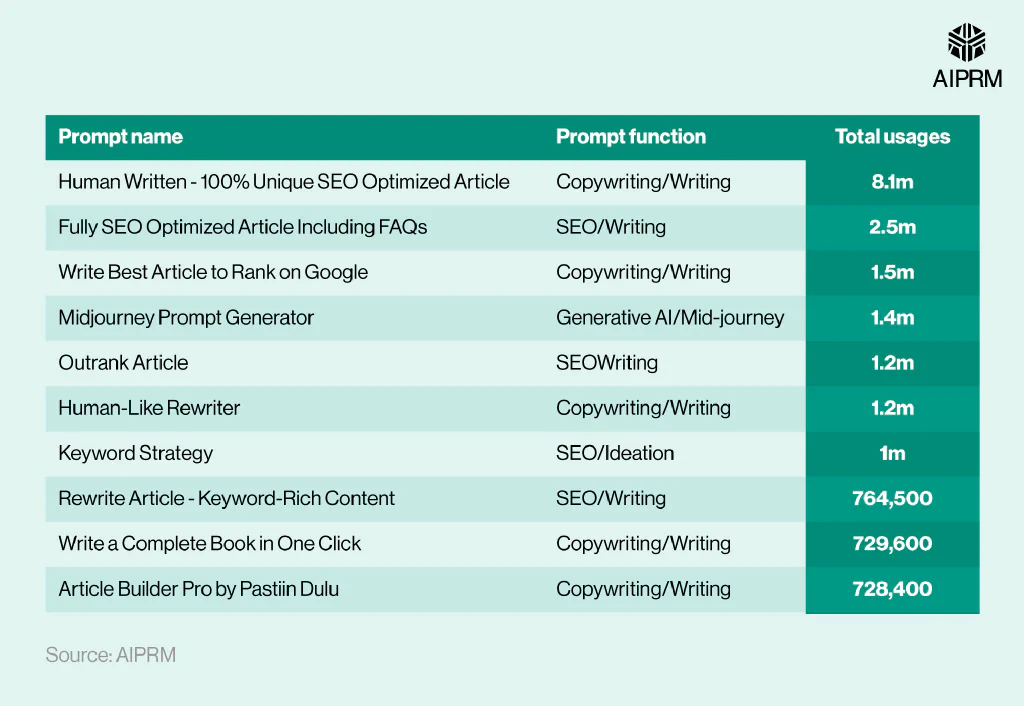
Only two non-writing-based prompts feature in the top 10, with one specialising in SEO and ideation (Keyword Strategy) and the other in generative AI ( Midjourney Prompt Generator). Combined, these two apps had 2.4 million usages and were responsible for the 8th and 4th highest numbers, respectively.
Just getting started? Take a look at our beginner’s guide to ChatGPT to find out more about how you can use ChatGPT to work for you. Alternatively, our Getting Started with ChatGPT tutorial will help you get signed up and started.
ChatGPT traffic statistics #
Where are the main traffic sources for ChatGPT? #
Analysis of ChatGPT statistics found that over 90% of the site’s traffic is direct. This means that more than nine out of 10 ChatGPT visits come from someone directly entering the site’s URL from a browser.
A breakdown of the marketing channels that generate the most traffic for ChatGPT
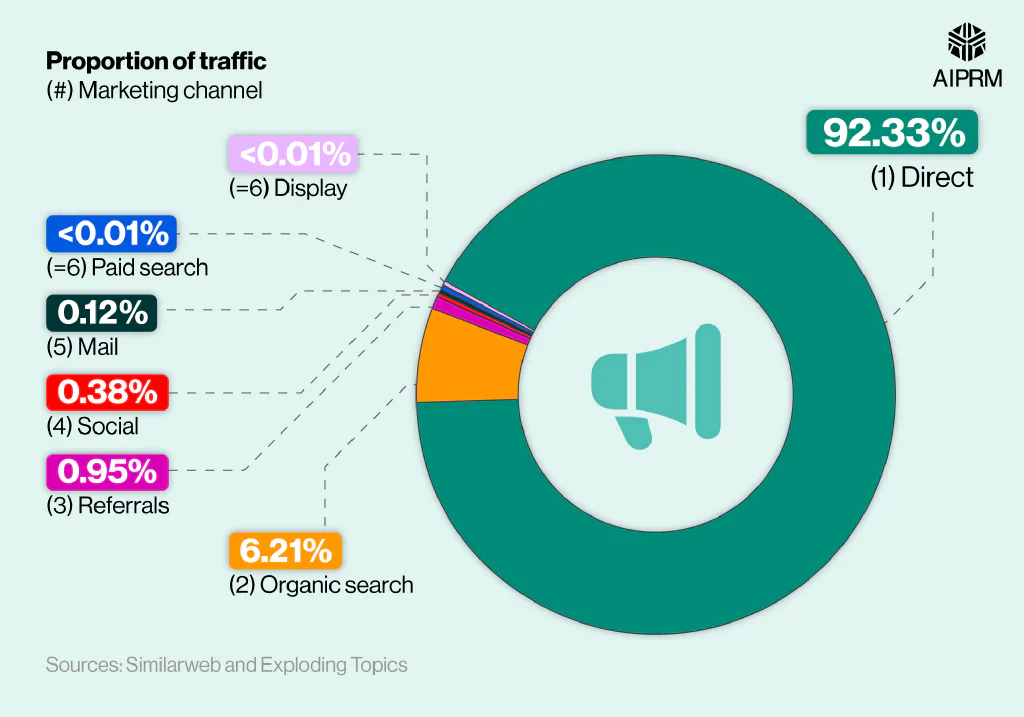
Organic search was the next most common traffic source, responsible for over a twentieth (6.21%) of ChatGPT traffic. This means that, combined, direct traffic and organic search traffic make up nearly 99% of ChatGPT’s total visits. According to Ahrefs, ChatGPT generates around 1.3 million visitors organically, with more than 900,000 coming from people searching either ‘ChatGPT’ or ‘Chat GPT’ directly.
Referrals were the third highest traffic source, accounting for just under 1% of site visits. Rounding off the top are social media (0.38%) and mail (0.12%), which together account for 0.5% of ChatGPT traffic.
What are the main social media marketing channels for ChatGPT? #
When it comes to social media channels, YouTube leads the way in generating ChatGPT traffic. The video and streaming platform is responsible for nearly half (48.86%) of ChatGPT’s social media-generated traffic – around a quarter (27%) more than any other site.
A breakdown of the social media channels that generate the most traffic for ChatGPT
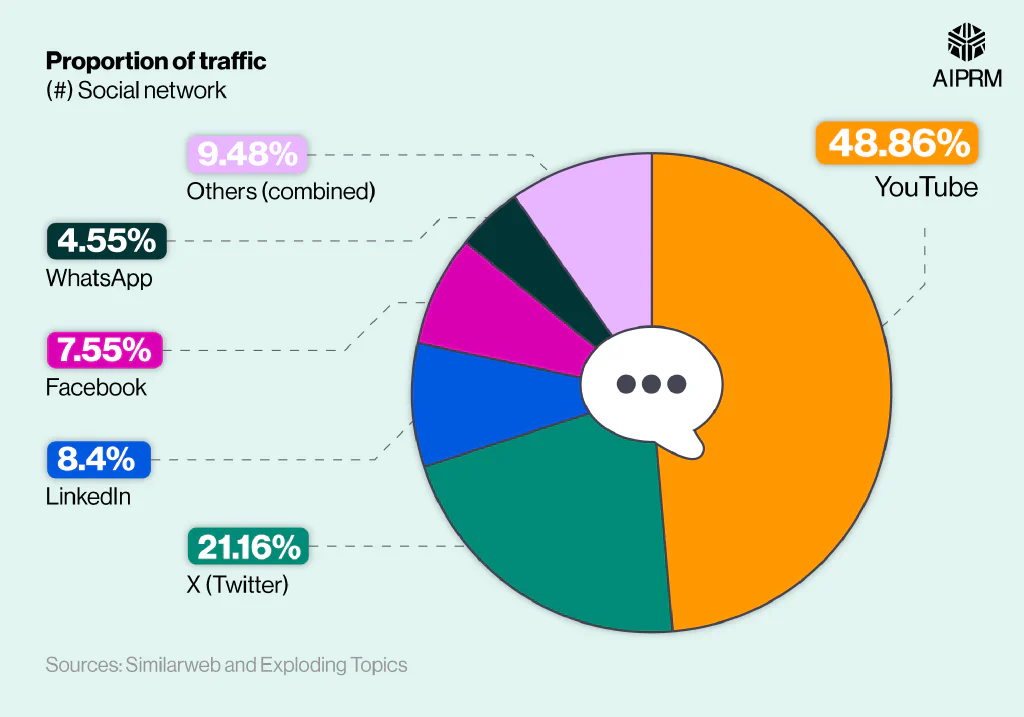
Following YouTube was X (formerly Twitter), with the site responsible for just over a fifth (21.16%) of ChatGPT traffic. This made X the only other platform to exceed 10% and was more than 12% higher than any other site except YouTube.
The only other sites responsible for more than 5% of ChatGPT’s social media traffic were LinkedIn (8.4%) and Facebook (7.55%). Combined, the two platforms were responsible for just under 16% of ChatGPT’s visits from social media.
What keywords are searched to access ChatGPT? #
Millions of people are searching for ChatGPT through search engines, with ‘ChatGPT’ being the keyword that generates the most traffic for the site. With an average monthly traffic of 25.8 million generated from this keyword alone, ‘ChatGPT’ generated almost two-thirds (65%) more traffic than the next keyword.
A breakdown of the keywords and phrases that generate the most traffic for ChatGPT
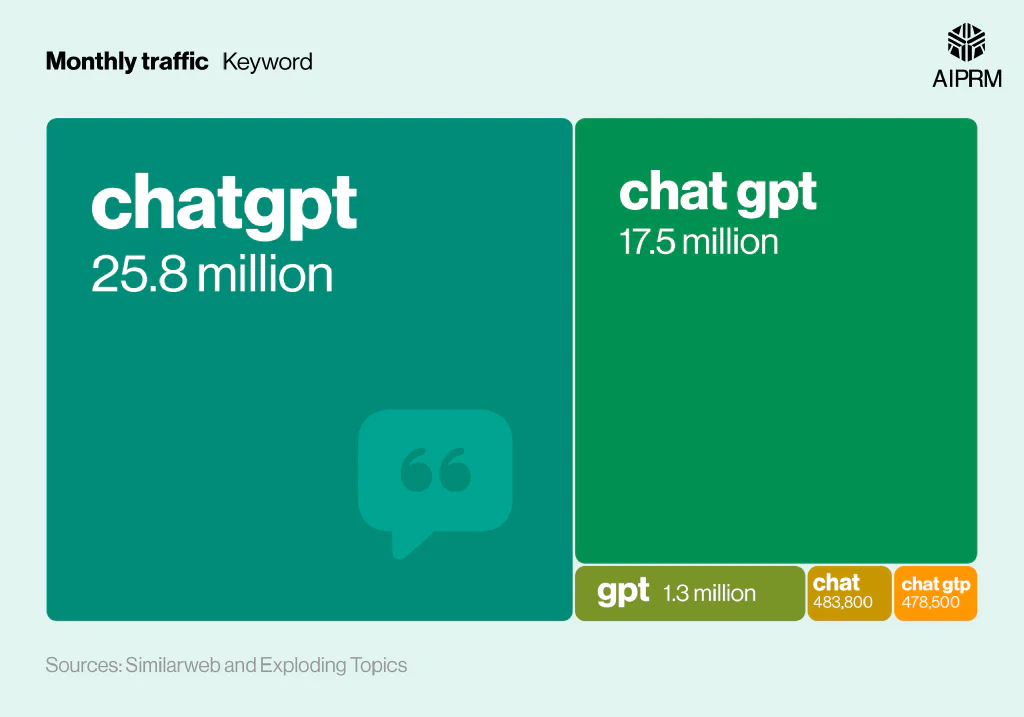
The next most common keyword was ‘Chat GPT’ which was responsible for 17.5 million monthly visitors. This was more than 13 times higher than the next most popular keyword and means that the two top keywords account for more than 43 million of ChatGPT’s monthly visitors.
The third most common keyword was ‘GPT’ (1.3 million), which was the only other word to exceed one million in traffic.
ChatGPT demographic statistics #
Which region/country uses ChatGPT most? #
Recent ChatGPT statistics found that the U.S. leads the way when it comes to ChatGPT users. Nearly 15% of the AI platform’s user base is found in the U.S. – 7.5% more than any other country.
A breakdown of the countries with the highest proportion of ChatGPT users
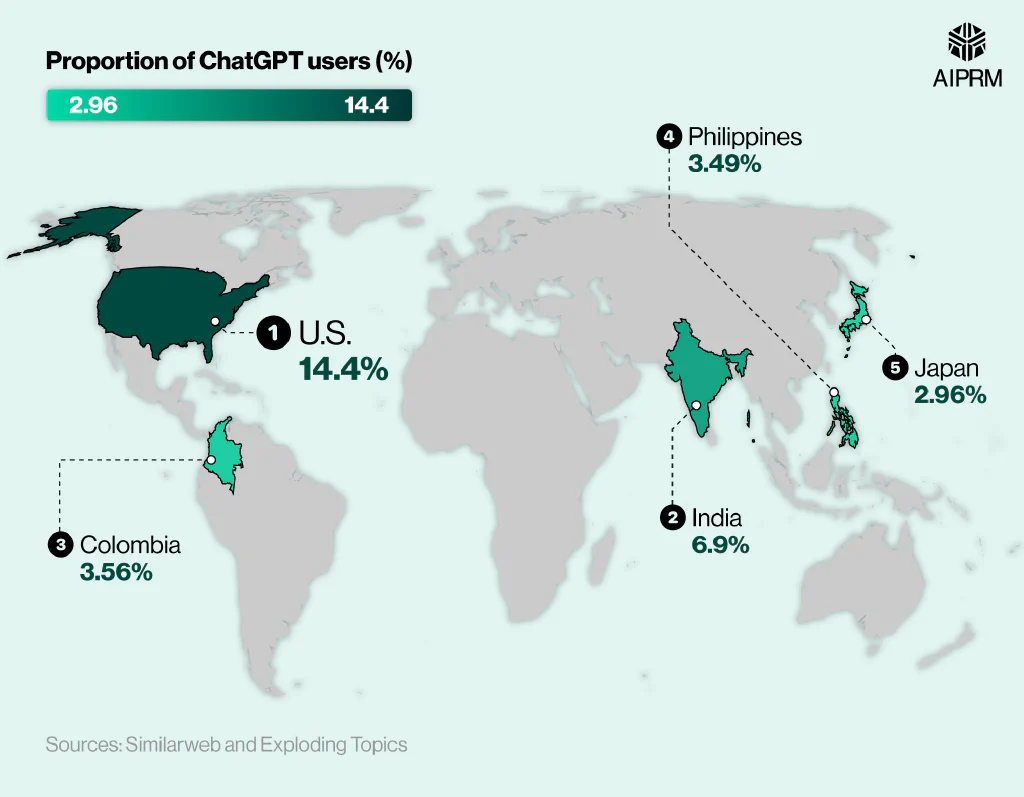
India had the next highest figures, accounting for nearly 7% (6.9%) of ChatGPT users – 3% more than any other nation.
Rounding off the top five are Columbia (3.56%), the Philippines (3.49%), and Japan (2.96%). Combined, these countries account for just over a tenth (10.04%) of the program’s total worldwide users.
A breakdown of the countries where ChatGPT is banned
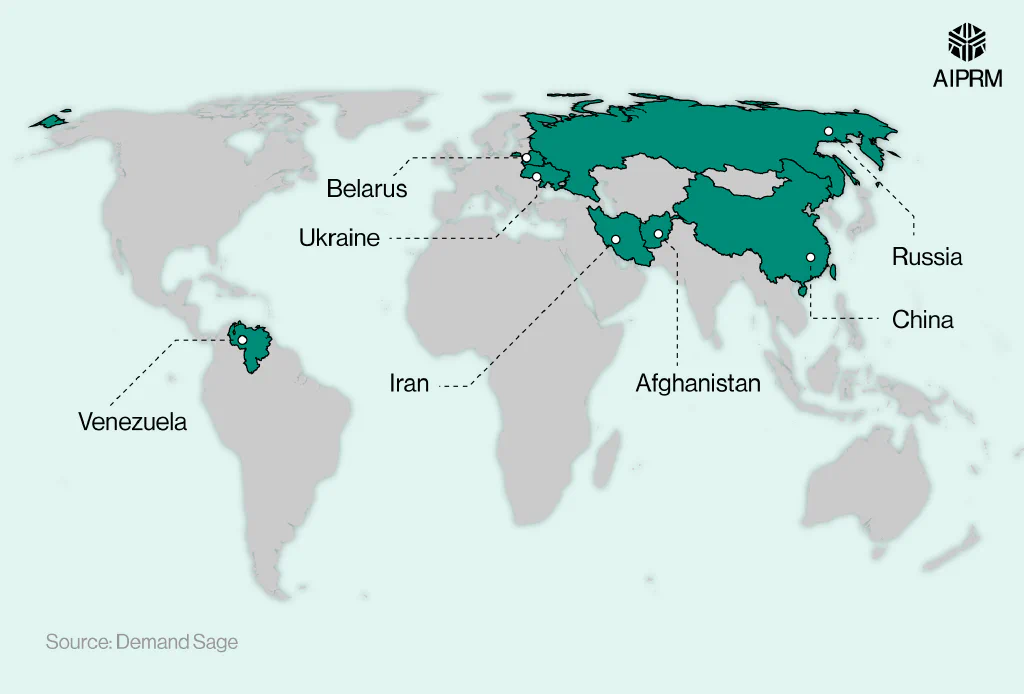
ChatGPT stats show that there are currently seven countries in which the AI tool is banned. Nearly 50% of the banned countries are from Eastern Europe, with Russia, Ukraine, and Belarus all nations that were part of the former Soviet Union.
The remaining four nations are more geographically diverse, with one each from South America (Venezuela), the Middle East (Iran), East Asia (China), and South Asia (Afghanistan).
Which city is responsible for the most AIPRM subscribers? #
AIPRM’s customer base is geographically diverse, with cities from eight different countries featuring in the top 20 places with the most subscribers. London is the city with the most subscribers, accounting for nearly 1% of the overall figure.
A breakdown of the top 20 cities with the highest percentage of AIPRM subscribers
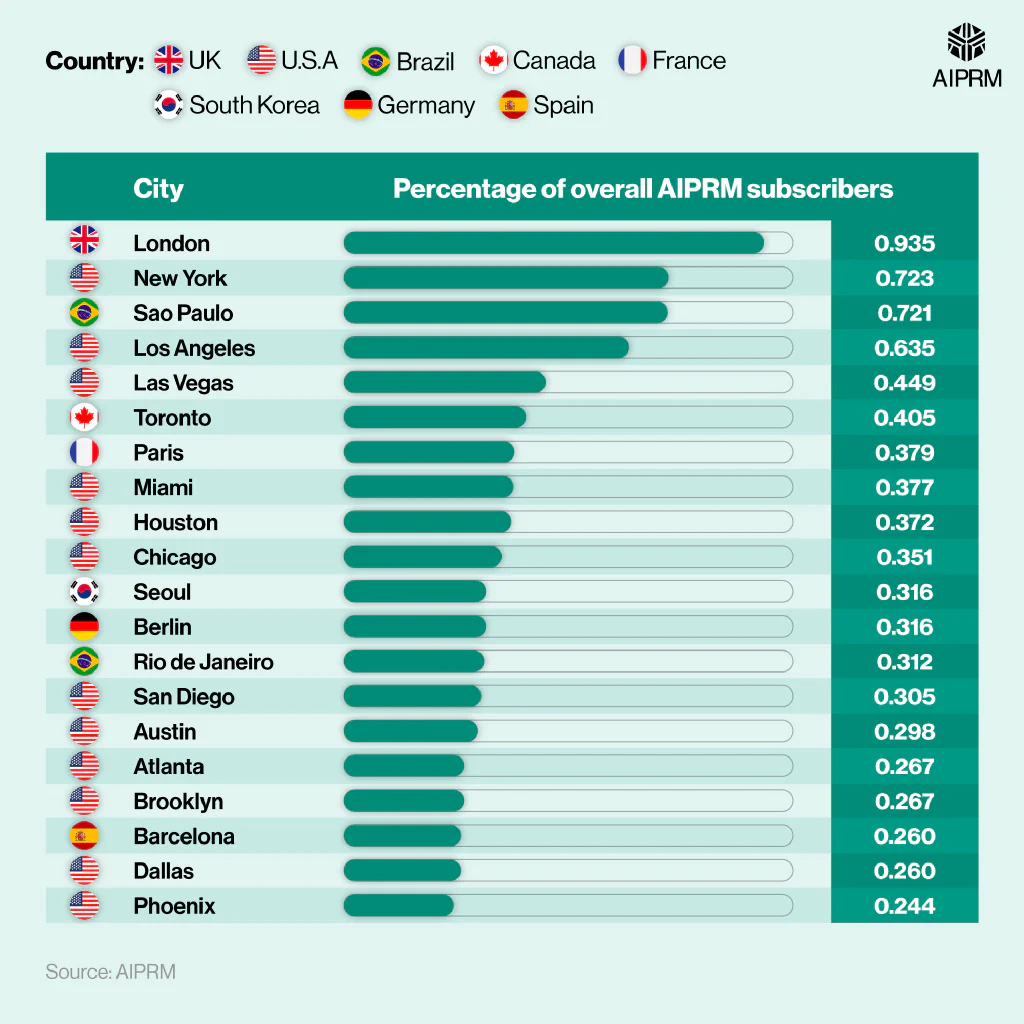
60% of the top 20 cities are based in the US, with New York (0.72%) having the most subscribers of these cities. This means that New York is the city with the second-highest percentage of AIPRM customers – around 0.1% higher than 4th placed Los Angeles but more than 0.2% lower than London.
Rounding off the top three is Sao Paolo, with the Brazilian city accounting for 0.72% of AIPRM subscribers. This makes Sao Paolo the only other city to hold more than 0.7% of AIPRM’s subscribers and is more than double the total found in Rio de Janeiro (0.31%).
Which age group uses ChatGPT most? #
Those aged 25-34 make up the highest proportion of ChatGPT users, with statistics finding that this age group is responsible for over a third (34.44%) of the site’s user base.
A breakdown of the proportion of ChatGPT users by age
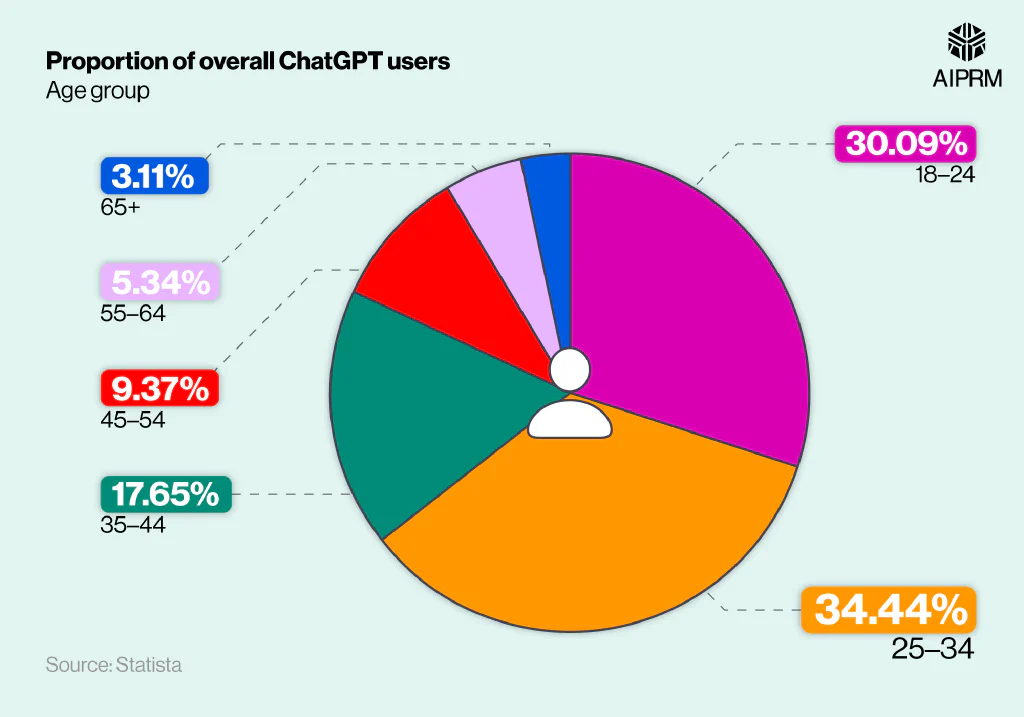
The next highest age group was those aged 18-24, who accounted for almost a third (30.09%) of ChatGPT users. This means that, combined, the two youngest age groups are responsible for nearly two-thirds (64.53%) of the platform’s overall users.
The number of ChatGPT users tends to decrease with age. Around a tenth (9.37%) are from the 45-54 age group, with this figure dropping to just over a twentieth (5.34%) for those aged 55-63 and less than one in 30 (3.11%) for those aged 65 and over.
Which age group has the most AIPRM users? #
We analysed our own data and found that those aged between 24 and 33 account for the highest portion of AIPRM users. There were a total of 687,947 users within this age group, accounting for more than a third (37%) of the total user base.
A breakdown of the total number of AIPRM users by age
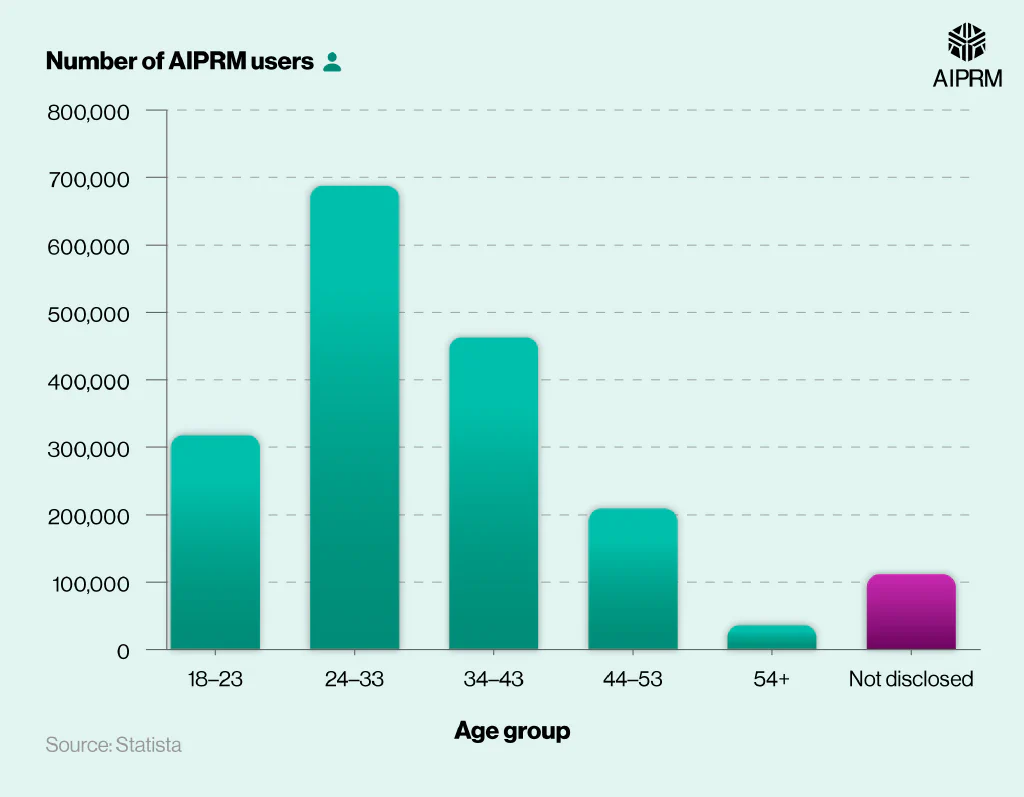
The next most prominent category was those aged 34-43, with just under 463,000 users – around a quarter (25%) of the total AIPRM users.
Less than one in five (17%) AIPRM users were in the youngest age category, with just over 318,000 aged between 18 and 24. This is considerably lower than the proportion of standard ChatGPT users in the lowest age group (30% aged 18-24).
Those aged 54 and above accounted for the lowest portion of AIPRM users, with a total of 36,502 – around 2% of total users.
How does ChatGPT awareness change with age? #
A survey from YouGov found that those in the younger age groups tend to be most experienced when it comes to ChatGPT. Less than a fifth (17%) of those aged 30-44 claim to have used the AI tool to generate text, which is the highest percentage of any age group.
This was followed closely by those aged 18-29, with 15% of respondents in this age category having used ChatGPT to generate text. Numbers dropped below 10% (9%) for those aged 45-54 and to just 5% for people aged 65 and above.
A breakdown of ChatGPT experience levels by age
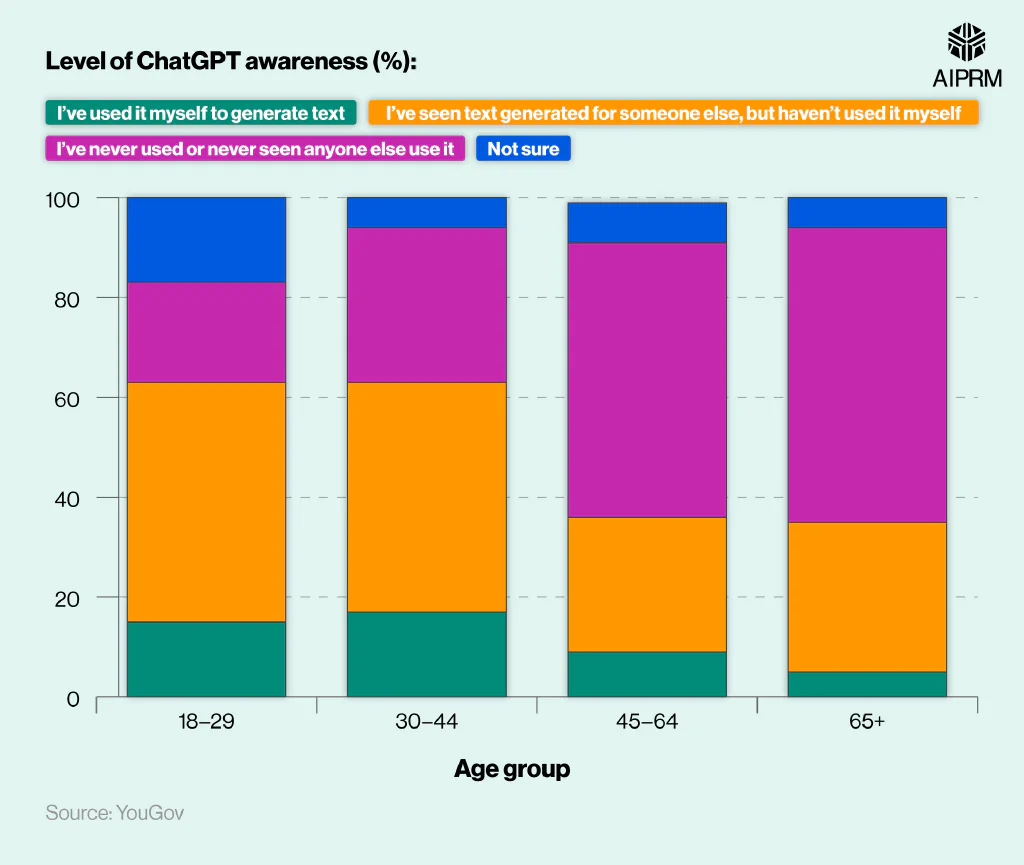
Nearly half (48%) of people aged 18-29 have seen ChatGPT text generated for someone else without using it themselves. This figure falls slightly to 46% (-2%) for those aged 30-44, before falling a further 19% in the 45-64 age bracket.
By the time we reach the highest age group (65+), less than a third (30%) claim to have seen ChatGPT-generated text.
Conversely, the number of people claiming to have never seen or used ChatGPT is lowest in the youngest age group (20%). This increases steadily with every passing age group, peaking at almost three-fifths (59%) for those aged 65 and over.
ChatGPT use by gender #
ChatGPT statistics show that nearly six in 10 (59.7%) of the platform’s users are male. This number drops to just over four in 10 (40.3%) when accounting for female users.
A breakdown of the proportion of Chat GPT users by gender
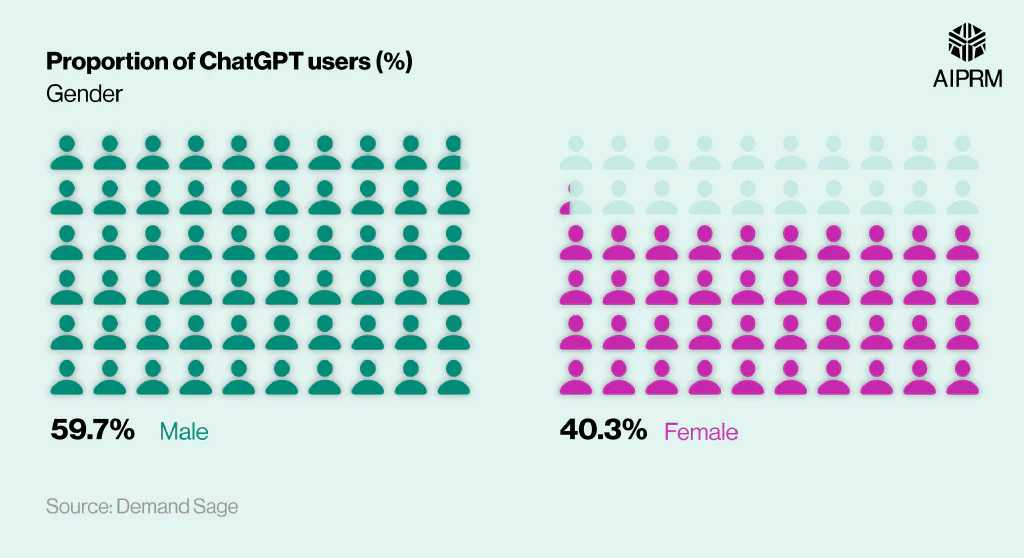
ChatGPT use by industry statistics #
A March 2023 survey from Statista asked businesses from an array of industries whether or not they use ChatGPT as a business function. More than a quarter (27.8%) of the businesses who used ChatGPT in the survey were from a technical background – the highest proportion of any sector.
A breakdown of the industries with the highest proportion of businesses that use ChatGPT
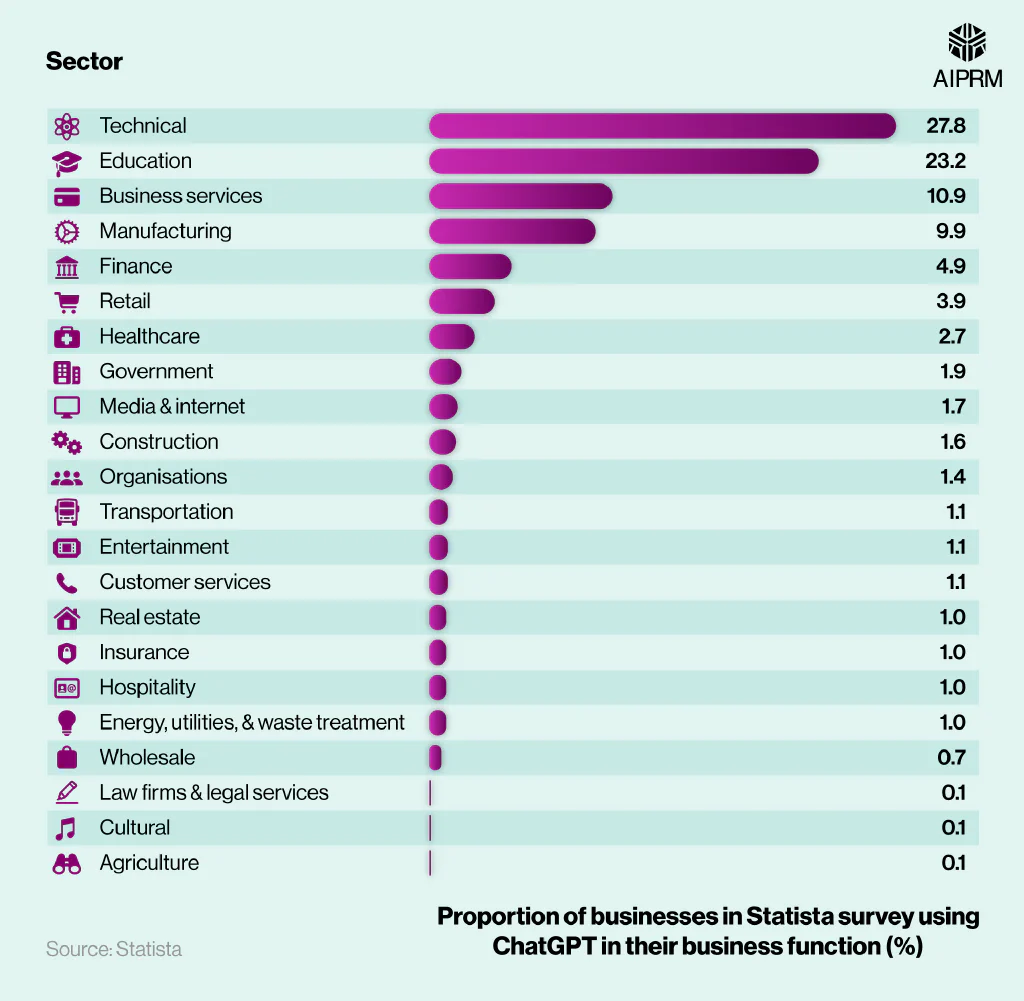
The next most prominent sector for ChatGPT implementation was Education, accounting for just under a quarter (23.2%) of businesses that used ChatGPT as a function. This means that the technical and education sectors are responsible for more than half (51%) of the businesses combined using ChatGPT in the survey.
Around one in 10 ChatGPT-using businesses were from business services – the third-highest figure. Rounding off the top five were manufacturing and finance, with totals of 9.9% and 4.9%, respectively.
Visit our blog to find out how ChatGPT can assist with a range of marketing tasks, from using ChatGPT for email marketing to creating social media strategies with ChatGPT.
How confident are people using ChatGPT? #
Our survey on ChatGPT statistics asked respondents how familiar they were with ChatGPT and other AI technologies, such as virtual assistants and face recognition.
More than half (54%) of respondents said they were ‘somewhat familiar’, with around a fifth (19.4%) believing they were ‘fairly familiar.
A breakdown of the familiarity levels of ChatGPT amongst AIPRM survey respondents
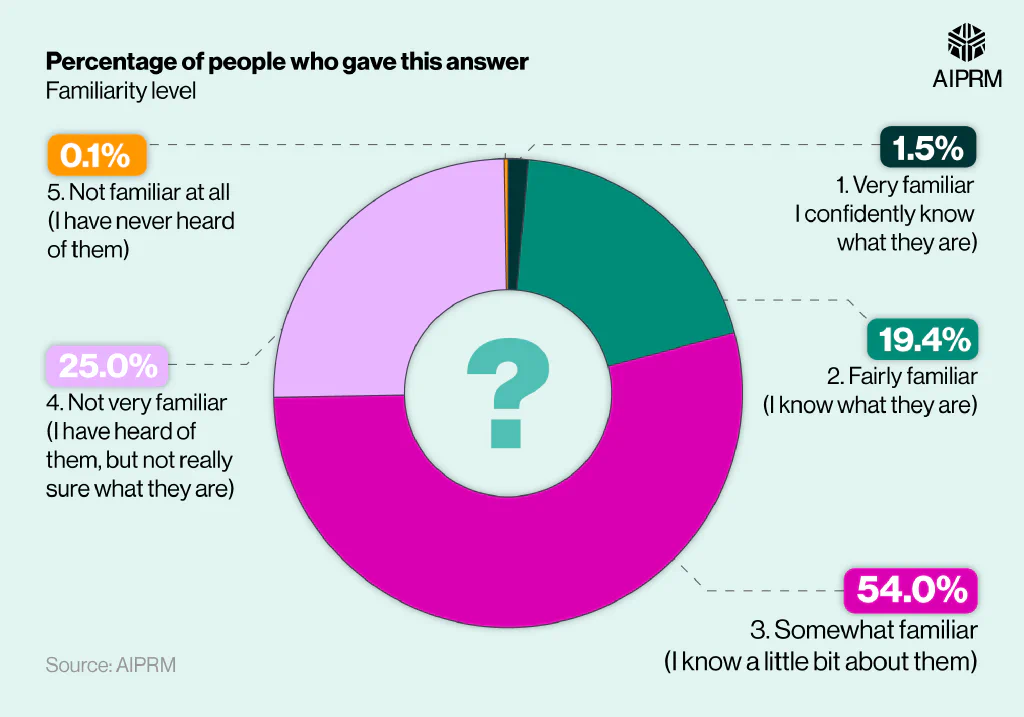
A quarter of respondents considered themselves to be ‘not very familiar’ with ChatGPT. This was nearly 6% more than those who were ‘fairly familiar’ but almost a third (29%) less than those who were ‘somewhat familiar’.
Less than 2% (1.5%) considered themselves to be ‘very familiar’ with ChatGPT, with roughly one in every thousand (0.1%) having not heard of the product at all.
How does educational background affect ChatGPT familiarity? #
The latest ChatGPT statistics show a direct correlation between education level and ChatGPT familiarity. A survey from Statista found that less than one in 10 (8%) people with a high school degree or less consider themselves to know a lot about ChatGPT. This figure rose to 13% for those with a college degree.
Nearly a quarter of people with a postgraduate degree said they knew a lot about the program – three times more than those with a high school degree or less.
A breakdown of the familiarity levels of ChatGPT by level of education
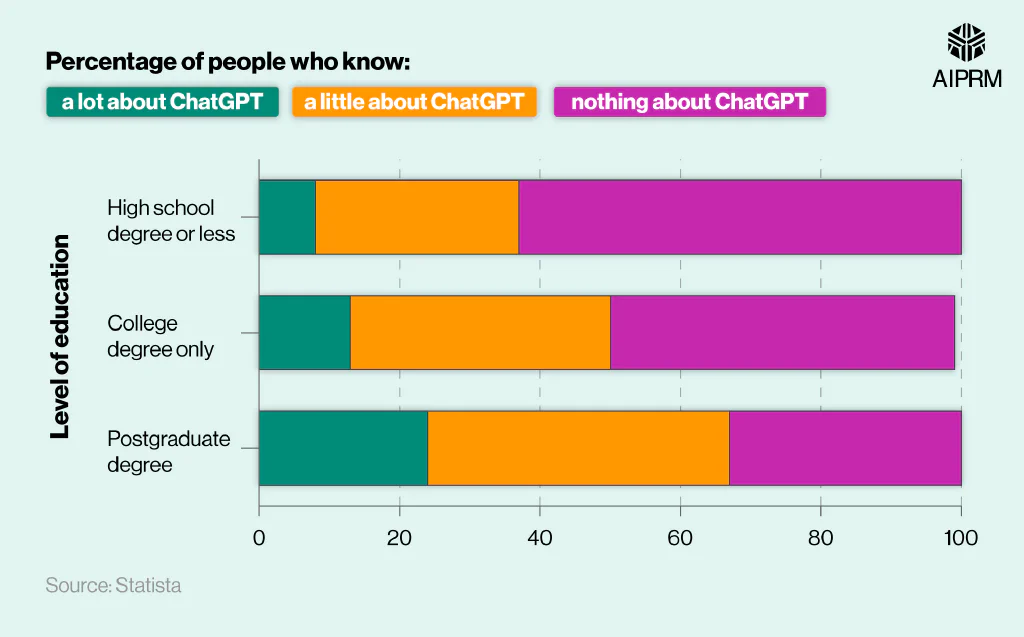
The survey also found that around three in 10 people with a high school degree or less knew a little about ChatGPT – 8% lower than those with a college degree (37%) and 14% less than those with a postgraduate degree (43%).
By contrast, those with a postgraduate degree were the least likely group to know anything about ChatGPT, with only a third (33%) of respondents stating this. This was 16% less than those with a college degree (49%) and 30% lower than high school-educated people (63%).
Check out our guide on ChatGPT for college students to find out how much ChatGPT can help with planning, writing, researching, and studying.
ChatGPT app statistics #
What are the most popular apps powered by ChatGPT? #
ChatGPT stats show that the AI Chatbot Nova is the most downloaded mobile app related to ChatGPT.
The Chatbot was downloaded around 23.3 million times between January and October 2023 – more than double the figure of any other app with the keywords ‘Chatbot’ or ‘ChatGPT’ in their title. This also means that the Nova app has around a quarter (27%) more downloads than the next nine most popular apps combined.
A breakdown of the number of worldwide downloads for various mobile apps using the keywords “chatbot” and “ChatGPT” in their title or description (January-October 2023)
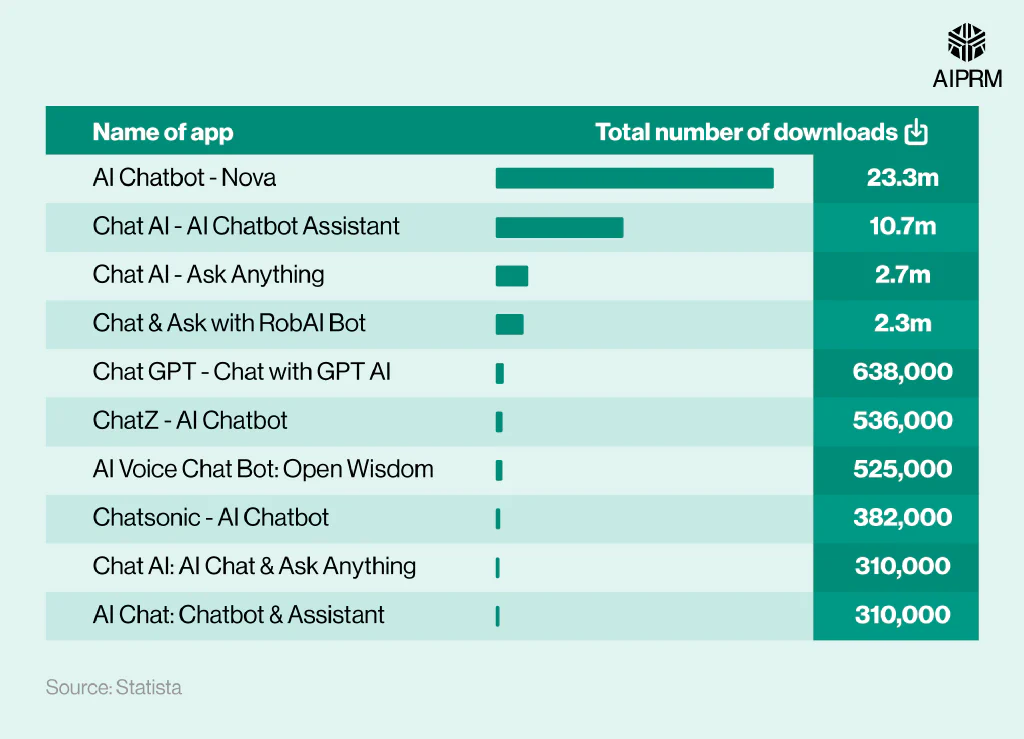
The AI Chatbot Assistant from Chat AI was the next most popular, with downloads of around 10.7m – almost 54% lower than the Nova AI Chatbot. This means that the Chat AI app has more than four times more downloads than the next most popular app and is the only other app with downloads above 10 million.
The only other apps with downloads exceeding one million were Chat AI - Ask Anything and Chat&Ask with Rob AI, with total downloads of 2.7m and 2.3m, respectively. Between January and October 2023, the two apps received a combined total of around five million downloads.
The future of ChatGPT #
To learn more about people’s expectations of ChatGPT in the future, AIPRM surveyed 6,000 people from various backgrounds, age groups, and industries on whether they believe ChatGPT has the potential to help with a variety of workplace tasks.
More than a quarter (28.8%) of respondents believed that ChatGPT will help generate content quicker. This was the most common potential outcome cited in the survey and was at least 4% more than any other outcome.
A breakdown of the percentage of survey respondents who believe ChatGPT will help with various workplace challenges
| Outcome | Percentage of people who believe ChatGPT will help achieve this outcome |
|---|---|
| Generate responses to customers (i.e. chatbots) | 24.8% |
| Generate content quicker | 28.8% |
| Create a personalized experience for customers | 20.8% |
| Increase web traffic | 6.4% |
| Streamline job processes | 24.5% |
| Summarize information | 15.2% |
| Improve decision-making | 18.7% |
| Improve business credibility | 10.7% |
| Translate information | 8.9% |
| Generate responses to colleagues (i.e. emails) | 18.2% |
| Create content in different languages | 13.6% |
| Fix coding errors | 8.3% |
| Generate website copy | 10.1% |
| None of the above | 10.4% |
(Source: AIPRM)
Nearly a quarter (24.8%) believed that ChatGPT would help generate customer responses, and a similar number (24.5%) believed that the chatbot would streamline job processes.
Additionally, more than a fifth (20.8%) believed the program would create a more personalized experience for customers – the only other outcome predicted by more than 20% of people.
Conversely, less than one in 10 people (8.3%) believed ChatGPT would be able to help them fix coding errors, with just under 9% predicting that it could translate information effectively. These figures are both less than a third of the number who believed ChatGPT could generate content quicker.
What advancements is ChatGPT making? #
Since its release in 2022, ChatGPT has revolutionized a range of communication-based tasks for millions worldwide. Yet, the impact of both the program and the technology behind it is still in its infancy.
ChatGPT has already built upon its originally released program. ChatGPT-4 was released in 2023 and is currently accessible to paid subscribers for a fee of £20 per month. This chatbot has improved upon many of the features found in the originally released 3.5 version that is still used by non-paying customers.
Below, we’ve broken down the differences between ChatGPT versions 3.5 and 4:
A comparative breakdown of the characteristics of ChatGPT-3.5 and ChatGPT-4
| Characteristics | GPT-3.5 | GPT-4 |
|---|---|---|
| Context length | 8,192 | 32,768 |
| Text length | 6,000 | 24,000 |
| Number of pages | 12 | 50 |
| Input type | Text | Text and images |
| Safety and security | 82% less likely to respond to disallowed content | 40% less likely to respond to harmful requests |
| Training data | Limited till January 2022 | Limited till April 2023 |
| Style | Can have a conversation in a human-like tone and can copy the dialect of any person or machine. | Can converse like humans but lacks emotional responses. |
| Reasoning | 3/5 | 5/5 |
| Speed | 5/5 | 2/5 |
| Conciseness | 2/5 | 4/5 |
(Source: Demand Sage)
ChatGPT version 4 allows text length of up to 24,000 characters – a rise of 600% from version 3.5 (3,000 characters).
Additionally, the latest model offers users a context length more than seven times higher than the previous version and has increased its page limit from six to 50 (+733%).
How easy is it to tell the difference between ChatGPT content and human writing? #
The latest ChatGPT statistics found that most people could not tell the difference between ChatGPT written content and copy written by a human.
A study from Tooltester presented a selection of content pieces written and proofed by ChatGPT and asked its readers to decide whether the content was AI-generated content or written by a human. More than half (53.1%) of respondents identified content generated by ChatGPT version 3.5 as human-written.
A breakdown of the percentage of people who identified a ChatGPT written text to be written by human
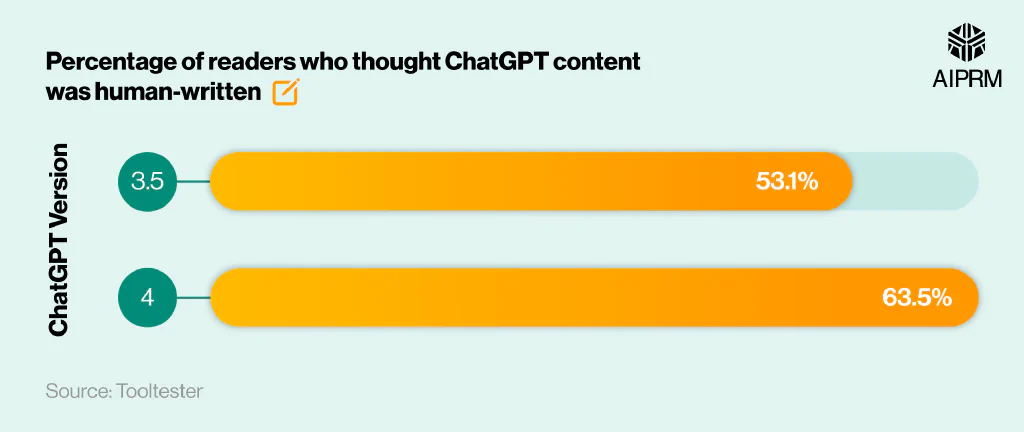
When it came to ChatGPT version 4 – the updated chatbot currently available to paid subscribers – the results were even more striking. Nearly two-thirds (63.5%) of respondents identified ChatGPT 4 generated content as human-written – a 12.2% increase from version 3.5.
Public opinions on ChatGPT #
A recent survey from Tidio analyzed ChatGPT attitudes from nearly a thousand internet users. The survey found six out of 10 (60%) people would be comfortable receiving medical advice and health-related consultations from ChatGPT.
Attitudes regarding education were similarly positive, with more than half (57%) stating they’d allow the AI tool to write their thesis for them.
By contrast, less than one in 10 (9%) said they would not use ChatGPT for academic purposes.
The survey also found that:
- Around 86% believe that ChatGPT could be used to control and manipulate the population
- Almost two-thirds (63%) of respondents feel that businesses should be allowed to advertise their products on ChatGPT like they do on Google Search
- 50% believe ChatGPT will eventually take over Google as the primary search engine
- More than a fifth (22%) would use it to help them pretend to be somebody else
- 50% are scared it will take their job
Which industries do people feel are most at risk from ChatGPT #
Recent ChatGPT statistics found that up to four in 10 (40%) people are afraid that ChatGPT will destroy the job market.
Software development was the job type people considered to be most at risk, with a third (33%) of survey respondents believing ChatGPT may eventually replace this job.
A breakdown of the percentage of people who believe ChatGPT may replace various jobs
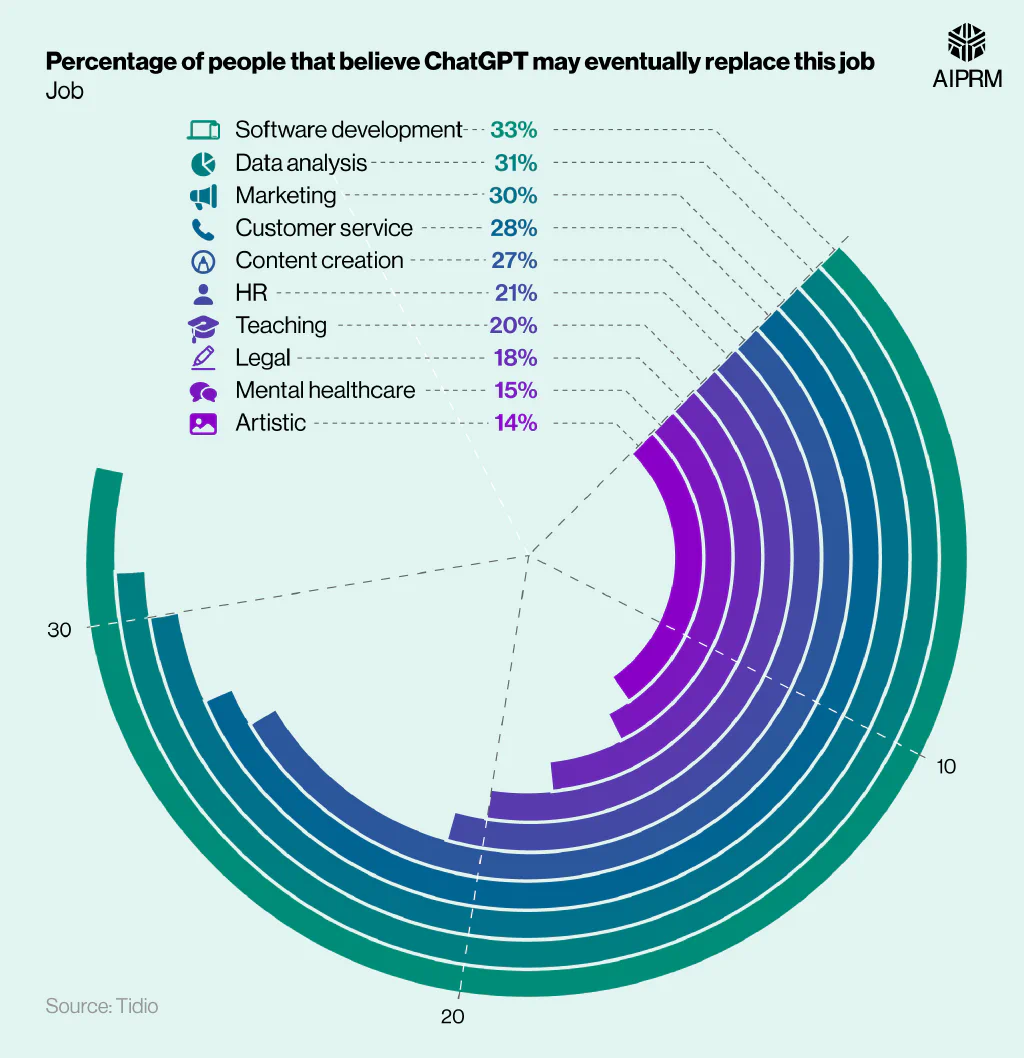
Data analysis and marketing were the next most popular answers, with around three in 10 (31% and 30%, respectively) believing these occupations may eventually be replaced by ChatGPT.
At the other end of the scale, just over one in 10 (14%) people felt that jobs in the arts were at risk from ChatGPT – around a fifth (19%) less than software development. Similarly, less than a sixth of internet users (15%) considered mental health jobs to be at risk from the program.
ChatGPT FAQs #
Who owns ChatGPT?
ChatGPT is owned by OpenAI, an AI-centred research company that is backed by Microsoft. Sam Altman is the CEO of OpenAI.
How does ChatGPT work?
Chat GPT works by breaking down language inputs into smaller components to analyse their meaning. It then predicts what the best answer or solution to your request will be, based on the data it was trained on.
What does ChatGPT stand for?
The full name of ChatGPT is Chat Generative Pre-Trained Transformer.
What can ChatGPT do?
ChatGPT allows you to have human-like conversations with a Chatbot, to help you answer questions and find solutions to an array of day-to-day tasks. The app can be used for numerous things, including answering questions, composing emails, writing essays, proofreading, and coding.
Will ChatGPT replace programmers?
Because of the expertise required to develop advanced software, it’s unlikely that ChatGPT will replace programmers anytime soon, if ever. ChatGPT can be used as a vital tool to assist programmers due to its ability to assist with less complex aspects of the job quickly and reliably.
How much does ChatGPT cost?
ChatGPT comes in both a free-to-use and paid subscription plan. The paid subscription plan is called ChatGPT+ and is powered by a newer chatbot with a more advanced language model (ChatGPT-4), containing a range of increased functionality benefits.
How does ChatGPT make money?
ChatGPT makes profits through a range of avenues, including selling API services to businesses and through its paid premium subscription plans. The program also sells its own training data sets and provides language consulting services.
How many users does ChatGPT have?
The latest ChatGPT statistics found that the program has over 180 million users, as of January 2024.
Will ChatGPT replace writers?
While ChatGPT is an excellent tool for writing copy, it’s unlikely to ever replace writers.
Although the program can produce content that is grammatically correct and factually accurate, it’s unlikely it will ever be able to replicate the creativity, originality, and nuance that is prominent in the best human writers.
How is ChatGPT integrated into educational institutions for academic purposes?
ChatGPT is integrated into educational institutions to assist in generating study materials, facilitating personalized learning experiences, and providing instant feedback on assignments. It’s used as a supplementary tool to enhance teaching methodologies and student engagement.
In Norway the Oslo school purchased ChatGPT for 110,000 students. Source
Can ChatGPT's language model be customized for specific business applications?
Yes, ChatGPT’s language model can be customized for specific business applications by using well written prompts, like those hundreds of very popular ChatGPT prompts you can find in AIPRM. This allows businesses to tailor the AI’s responses to fit their particular needs, enhancing customer service, content generation, and internal processes.
In addition to that additional documents and knowledge will be accessible using the RAGIDX feature in AIPRM. More about RAGIDX
What measures are in place to ensure ChatGPT-generated content maintains ethical standards?
ChatGPT incorporates safety and security mechanisms to reduce the likelihood of generating harmful or biased content. These include filters for disallowed content, moderation tools, and ongoing updates to its training data to address ethical concerns and biases.
How does ChatGPT handle languages other than English, and what is its accuracy?
ChatGPT supports multiple languages and can generate, understand, and translate text across them. While its proficiency varies depending on the language due to the volume and quality of training data available, continuous improvements are made to enhance its accuracy and natural language understanding in less represented languages.
What future developments are expected for ChatGPT in terms of functionalities and features?
Future developments for ChatGPT include enhancements in contextual understanding, personalization capabilities, and multimodal interactions (text, voice, and images). Further advancements also aim to improve its reasoning abilities, reduce response times, and expand its ethical guidelines to better manage complex user requests.
How does ChatGPT contribute to the automation of routine tasks in the workplace?
ChatGPT automates routine tasks in the workplace by handling repetitive inquiries, drafting emails, generating reports, and assisting with coding tasks. This allows employees to focus on more complex and creative aspects of their jobs, improving productivity and efficiency.
In what ways is ChatGPT being utilized for creative writing and content generation?
ChatGPT is used for creative writing and content generation by providing suggestions for storylines, composing poetry, writing articles, and creating engaging social media content. It helps writers overcome writer’s block and generate ideas, enhancing creativity and content diversity.
How does ChatGPT assist in language learning and translation tasks?
ChatGPT aids in language learning by offering conversational practice, grammar corrections, vocabulary expansion, and cultural insights. For translation tasks, it provides real-time translations between languages, helping users understand and communicate in foreign languages more effectively.
What are the environmental impacts of running large AI models like ChatGPT, and how are they being addressed?
Running large AI models like ChatGPT requires significant computational resources, leading to high energy consumption and potential environmental impacts. Efforts to address these include optimizing AI algorithms for efficiency, using renewable energy sources for data centers, and developing more energy-efficient hardware.
Who owns ChatGPT?
ChatGPT is owned by OpenAI, an AI-centred research company that is backed by Microsoft. Sam Altman is the CEO of OpenAI.
How does ChatGPT work?
Chat GPT works by breaking down language inputs into smaller components to analyse their meaning. It then predicts what the best answer or solution to your request will be, based on the data it was trained on.
What does ChatGPT stand for?
The full name of ChatGPT is Chat Generative Pre-Trained Transformer.
What can ChatGPT do?
ChatGPT allows you to have human-like conversations with a Chatbot, to help you answer questions and find solutions to an array of day-to-day tasks. The app can be used for numerous things, including answering questions, composing emails, writing essays, proofreading, and coding.
Will ChatGPT replace programmers?
Because of the expertise required to develop advanced software, it’s unlikely that ChatGPT will replace programmers anytime soon, if ever. ChatGPT can be used as a vital tool to assist programmers due to its ability to assist with less complex aspects of the job quickly and reliably.
How much does ChatGPT cost?
ChatGPT comes in both a free-to-use and paid subscription plan. The paid subscription plan is called ChatGPT+ and is powered by a newer chatbot with a more advanced language model (ChatGPT-4), containing a range of increased functionality benefits.
How does ChatGPT make money?
ChatGPT makes profits through a range of avenues, including selling API services to businesses and through its paid premium subscription plans. The program also sells its own training data sets and provides language consulting services.
How many users does ChatGPT have?
The latest ChatGPT statistics found that the program has over 180 million users, as of January 2024.
Will ChatGPT replace writers?
While ChatGPT is an excellent tool for writing copy, it’s unlikely to ever replace writers.
Although the program can produce content that is grammatically correct and factually accurate, it’s unlikely it will ever be able to replicate the creativity, originality, and nuance that is prominent in the best human writers.
How is ChatGPT integrated into educational institutions for academic purposes?
ChatGPT is integrated into educational institutions to assist in generating study materials, facilitating personalized learning experiences, and providing instant feedback on assignments. It’s used as a supplementary tool to enhance teaching methodologies and student engagement.
In Norway the Oslo school purchased ChatGPT for 110,000 students. Source
Can ChatGPT's language model be customized for specific business applications?
Yes, ChatGPT’s language model can be customized for specific business applications by using well written prompts, like those hundreds of very popular ChatGPT prompts you can find in AIPRM. This allows businesses to tailor the AI’s responses to fit their particular needs, enhancing customer service, content generation, and internal processes.
In addition to that additional documents and knowledge will be accessible using the RAGIDX feature in AIPRM. More about RAGIDX
What measures are in place to ensure ChatGPT-generated content maintains ethical standards?
ChatGPT incorporates safety and security mechanisms to reduce the likelihood of generating harmful or biased content. These include filters for disallowed content, moderation tools, and ongoing updates to its training data to address ethical concerns and biases.
How does ChatGPT handle languages other than English, and what is its accuracy?
ChatGPT supports multiple languages and can generate, understand, and translate text across them. While its proficiency varies depending on the language due to the volume and quality of training data available, continuous improvements are made to enhance its accuracy and natural language understanding in less represented languages.
What future developments are expected for ChatGPT in terms of functionalities and features?
Future developments for ChatGPT include enhancements in contextual understanding, personalization capabilities, and multimodal interactions (text, voice, and images). Further advancements also aim to improve its reasoning abilities, reduce response times, and expand its ethical guidelines to better manage complex user requests.
How does ChatGPT contribute to the automation of routine tasks in the workplace?
ChatGPT automates routine tasks in the workplace by handling repetitive inquiries, drafting emails, generating reports, and assisting with coding tasks. This allows employees to focus on more complex and creative aspects of their jobs, improving productivity and efficiency.
In what ways is ChatGPT being utilized for creative writing and content generation?
ChatGPT is used for creative writing and content generation by providing suggestions for storylines, composing poetry, writing articles, and creating engaging social media content. It helps writers overcome writer’s block and generate ideas, enhancing creativity and content diversity.
How does ChatGPT assist in language learning and translation tasks?
ChatGPT aids in language learning by offering conversational practice, grammar corrections, vocabulary expansion, and cultural insights. For translation tasks, it provides real-time translations between languages, helping users understand and communicate in foreign languages more effectively.
What are the environmental impacts of running large AI models like ChatGPT, and how are they being addressed?
Running large AI models like ChatGPT requires significant computational resources, leading to high energy consumption and potential environmental impacts. Efforts to address these include optimizing AI algorithms for efficiency, using renewable energy sources for data centers, and developing more energy-efficient hardware.
ChatGPT Glossary #
Artificial Intelligence (AI) #
AI refers to any practice in which computer intelligence is used to carry out tasks normally requiring human intelligence, such as speech recognition, decision-making, visual perception, and language.
Chatbot #
A computerized program that communicates with humans through simulated human language.
ChatGPT #
An AI chatbot produced by OpenAI that uses large language model technology to communicate with humans and assist with various tasks.
Generative AI #
A content-creating technology that uses AI to create text, video, computer code, or images. The AI tool is fed vast amounts of training data to help it find patterns to generate its own independent responses.
SEO #
Search Engine Optimisation (SEO) is the process of optimising your website to increase its visibility to Google and other search engines. The objective of SEO is to enhance a website’s position in the Search Engine Results Pages (SERPs) and bring more traffic to the site.
Full AIPRM Glossary of AI terms #
For more terms, please refer to our Generative AI Glossary here.
Sources and Methodology #
https://www.similarweb.com/website/chat.openai.com/#overview https://explodingtopics.com/blog/chatgpt-users
https://www.namepepper.com/chatgpt-users
https://www.statista.com/statistics/1386342/chat-gpt-app-downloads/ https://www.statista.com/statistics/1366930/chatgpt-google-search-weekly-worldwide/
https://www.demandsage.com/chatgpt-statistics/
https://www.tidio.com/blog/chat-gpt/
https://www.statista.com/statistics/1369168/knowledge-of-chatgpt-by-education-in-us/
https://www.statista.com/statistics/1384324/chat-gpt-demographic-usage/
https://www.statista.com/statistics/1384323/industries-using-chatgpt-in-business/ https://www.the74million.org/article/national-chatgpt-survey-teachers-accepting-ai-into-classrooms-workflow-even-more-than-students/ https://www.statista.com/statistics/1388492/journalists-using-chatgpt-in-newsrooms-worldwide/
https://www.statista.com/statistics/1386364/chat-gpt-in-app-revenues/
https://www.statista.com/statistics/1357710/chatbot-chatgpt-keyword-app-downloads/
https://today.yougov.com/technology/articles/45128-what-americans-think-about-chatgpt-and-ai-text
https://www.statista.com/statistics/1383112/sea-top-user-concerns-about-chat-gpt-by-country/
https://www.statista.com/statistics/1388492/journalists-using-chatgpt-in-newsrooms-worldwide/